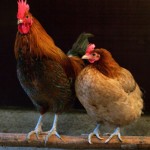New dangers from bird flu
U.S. government asks scientists to keep some secrets about their bird flu research

The viruses that cause “bird flu” spread easily among chickens, ducks and turkeys, often causing serious illness and sometimes death. These viruses don’t usually spread to humans, but it happens. And when it does, the results can be deadly. According to the Centers for Disease Control and Prevention, based in Atlanta, about 6 of every 10 people infected with the bird flu virus called H5N1 have died. If the virus ever did pass easily between people, it would cause widespread harm around the world.
Understandably, scientists want to know more about the virus and how it spreads to try to prevent a disaster. In two recent studies, scientists demonstrated how the virus could be changed to pass more easily between mammals, making it more infectious. (In the experiments, the scientists tested the virus on ferrets.)
In the hands of a bioterrorist who wants to cause harm on a large scale, such studies might be dangerous. They show how to turn H5N1 into a deadly biological weapon. That’s the concern of a committee organized by the National Institutes of Health (NIH), which is part of the U.S. government and the world’s largest medical research agency. The committee studied the new H5N1 papers and concluded that the virus could be made very dangerous, and that the new papers show how to do it.
An NIH statement from December 20, 2011, acknowledges that this kind of research can benefit the public. On the other hand, according to the statement, “Certain information obtained through such studies has the potential to be misused for harmful purposes.” The NIH argues that some of the information in the studies should be kept under lock and key — and only shared with certain scientists on a demonstrated need-to-know basis. If terrorists created an H5N1 virus that spreads easily, they could start a global health threat. The NIH panel has therefore recommended that the scientists and scientific journals publishing the studies release the conclusions of the experiments — but withhold the methods used to make the germ more infectious.
The U.S. government agrees with the panel’s recommendation. The government has formally requested, but not demanded, that scientists and journals hold back some of their new bird flu data. The editors of the journals are considering the request.
The U.S. government already has rules in place that permit only some people to know secrets about nuclear weapons. Scientists need access to information, but the same information should be kept away from people with the intent to harm. The question is: Who gets to decide which people can see the science, and how much of it?
The tricky part of this decision-making process is “drawing the line at which aspects of science are too risky to share,” Janet Raloff wrote in an article for Science News. Shrouding too much scientific research in secrecy may slow the advance of important scientific fields. But if studies like the recent H5N1 experiments always become public knowledge, they could offer terrorists easy access to dangerous new weapons.
This back-and-forth between the government and the scientific community over bird-flu data shows that both sides are struggling to find the right answer. It also shows that medical research has moved into sensitive terrain, where there are no easy answers.
POWER WORDS (adapted from the New Oxford American Dictionary)
flu, or influenza A highly contagious viral infection of the respiratory passages that causes fever, swelling and severe aching.
virus An infection-causing agent that typically has genetic material surrounded by a protein coat. A virus is too small to be seen under the microscope and is able to multiply only within the living cells of a host organism.
infectious Likely to be transmitted to people, organisms, etc., through the environment.
bioterrorism Terrorism involving the release of toxic biological agents.







